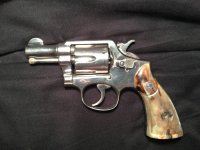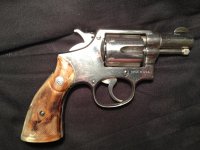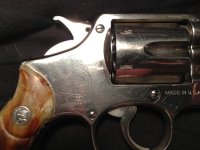Hello all new member here,
I recently acquired a Smith & Wesson revolver from my father-in-law.
He didn't know much about it, and I would like to find out things like the model and the era it was made.
Also, I think it uses .38 S&W, but I'm not positive. My father in law said it might be a .32?
There are two numbers on it. 64746 is on the cylinder and frame when you pull the cylinder down.
7304xx is on the bottom side of the barrel and bottom of the grip.
I'm sorry for any incorrect terminology, this is my first of hopefully many guns.
Thanks.
Here are some pictures:
I recently acquired a Smith & Wesson revolver from my father-in-law.
He didn't know much about it, and I would like to find out things like the model and the era it was made.
Also, I think it uses .38 S&W, but I'm not positive. My father in law said it might be a .32?
There are two numbers on it. 64746 is on the cylinder and frame when you pull the cylinder down.
7304xx is on the bottom side of the barrel and bottom of the grip.
I'm sorry for any incorrect terminology, this is my first of hopefully many guns.
Thanks.
Here are some pictures:
Attachments
Last edited:



